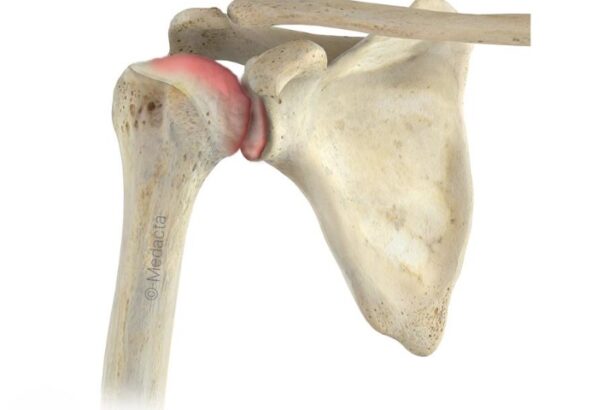
The shoulder joint in inherently unstable due to its incredible mobility which allows the arm to move in many different directions. This instability makes the joint prone to dislocation, where the ball and socket within the joint becomes separated. This can occur in any direction; backward, forward or downward and is most commonly caused by trauma.
Causes of shoulder instability/dislocation
Shoulder instability occurs when the head of the upper arm bone (the humerus) is forced out of the socket of the shoulder blade (the glenoid). The causes of shoulder instability/dislocation can be traumatic or non-traumatic, and some common causes include:
Trauma: A sudden impact or injury, such as a fall or a blow to the shoulder, can cause the shoulder to dislocate.
Repetitive strain: Repetitive overhead motions, such as those performed in sports like tennis or swimming, can cause shoulder instability over time.
Ligament or muscle weakness: Ligament or muscle weakness due to age, injury, or other medical conditions can lead to shoulder instability.
Congenital factors: Some individuals may be born with lax ligaments, making them more prone to shoulder instability.
Previous shoulder injuries: Previous shoulder injuries or dislocations can increase the likelihood of future instability or dislocations.
Structural abnormalities: Structural abnormalities in the shoulder joint, such as a shallow glenoid or a larger than normal humeral head, can make the joint more prone to instability.
Connective tissue disorders: Certain connective tissue disorders, such as Ehlers-Danlos syndrome, can cause ligament and joint laxity, leading to shoulder instability.
It’s important to seek medical attention if you experience shoulder instability or dislocation, as repeated dislocations can lead to chronic shoulder instability and joint damage.
Symptoms a dislocated shoulder
The symptoms of a dislocated shoulder can vary depending on the severity of the injury, but common symptoms include:
Sudden and severe pain in the shoulder: The pain may be intense and can occur during movement or when pressure is applied to the joint.
Limited range of motion: The ability to move the arm may be limited or completely restricted due to pain and joint instability.
Swelling and bruising: The affected area may be swollen and bruised due to the injury.
Deformity: The shoulder may appear deformed or out of place, and the affected arm may hang lower than the unaffected arm.
Numbness or tingling: Numbness or tingling in the arm or hand may occur due to nerve damage caused by the dislocation.
Muscle spasms: Muscle spasms may occur around the shoulder joint, making it difficult to move the arm.
Weakness: The affected arm may feel weak and unable to support weight.
Diagnosing a shoulder dislocation
Shoulder dislocations are often traumatic, and a diagnosis will usually involves a physical examination, medical history review, and imaging tests.
Following are some steps Dr Singh may take to diagnose a dislocated shoulder:
Physical examination: Dr Singh will perform a physical examination of the shoulder to assess the range of motion, check for deformities, and identify areas of tenderness or swelling.
Medical history review: Dr Singh will review your medical history, including any previous injuries, surgeries, or medical conditions that may affect the shoulder.
Imaging tests: Imaging tests, such as X-rays or an MRI, may be ordered to confirm the diagnosis and assess the severity of the dislocation. These tests can also help identify any associated injuries, such as fractures or soft tissue damage.
Joint injection: In some cases, a joint injection with a local anaesthetic may be used to confirm the diagnosis. If the anaesthetic provides immediate relief, it may indicate that the pain was caused by a dislocation.
Treating a shoulder dislocation
The treatment options for shoulder instability or dislocation depend on the severity and underlying cause of the injury so Dr Singh will individualise a treatment plan to meet each patient’s specific needs.
Here are some common treatment options:
Reduction: In some cases, Dr Singh may be able to manually reduce the dislocated shoulder back into its socket. This is often done with a local anaesthetic to ease pain and muscle spasms.
Immobilisation: After the reduction, the shoulder may be immobilised with a sling or brace for a period of time to allow the soft tissues to heal.
Rehabilitation exercises: Once the shoulder is stable, rehabilitation exercises may be prescribed to strengthen the muscles and improve range of motion.
Surgery: In cases where the injury is severe or recurrent, surgery may be necessary to repair the damaged soft tissues, such as torn ligaments or tendons, and stabilise the joint. Surgery may involve arthroscopic procedures or open surgery.
Medications: Pain medications, anti-inflammatory medications, and muscle relaxants may be prescribed to help manage pain and inflammation.
It’s important to seek medical attention if you experience shoulder instability or dislocation, as repeated dislocations can lead to chronic shoulder instability and joint damage. Dr Singh can diagnose the underlying cause of your shoulder instability or dislocation and recommend an appropriate treatment plan for you.
 Christmas Operating Hours
Christmas Operating Hours 
















